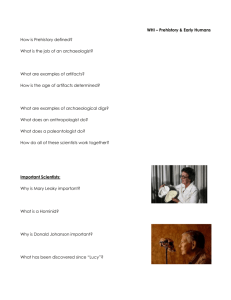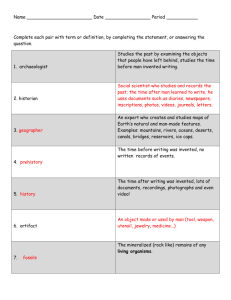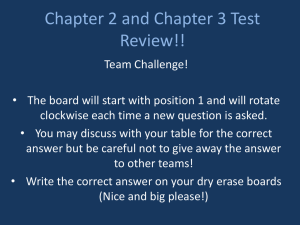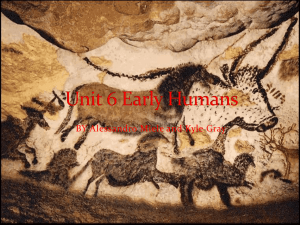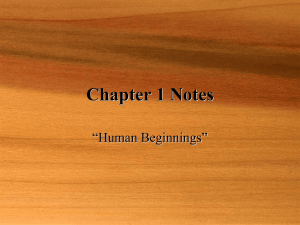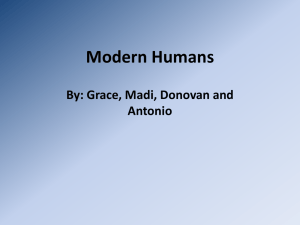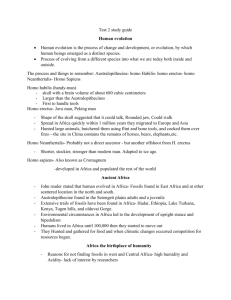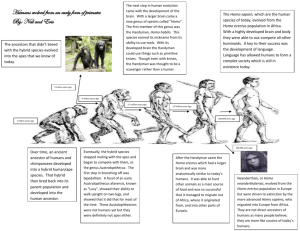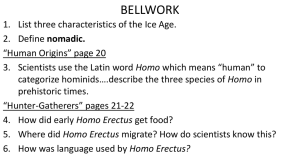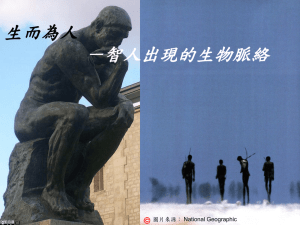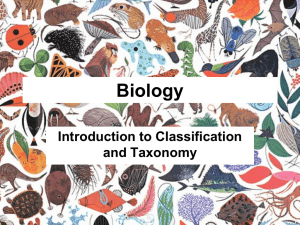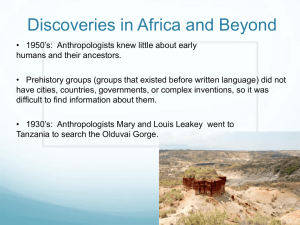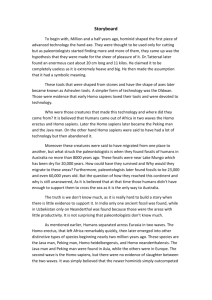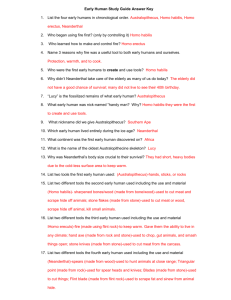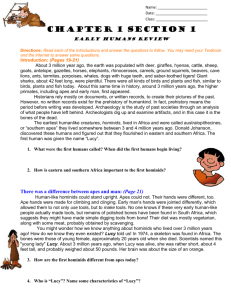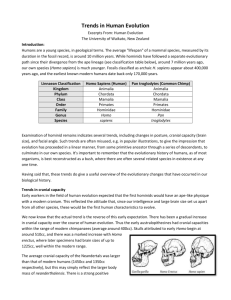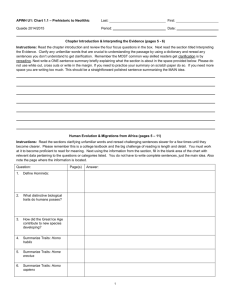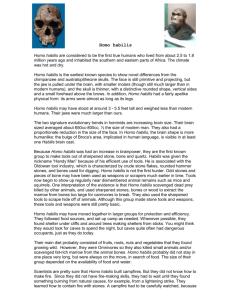World History I -Test- Geography and Early Man Which of the
advertisement
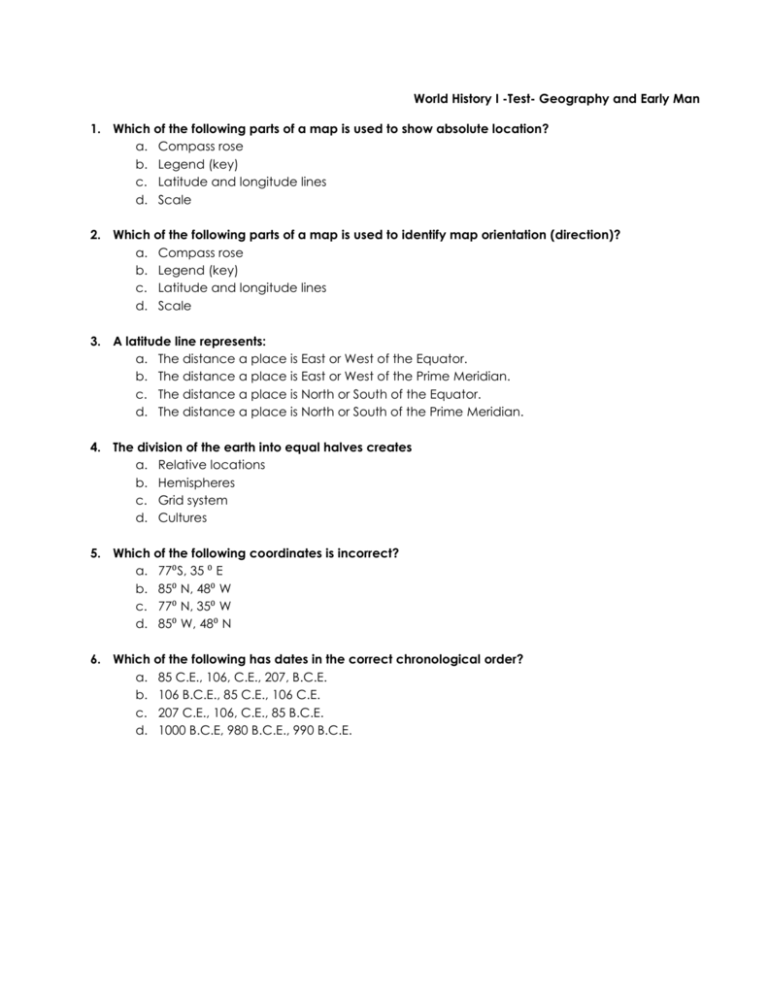
World History I -Test- Geography and Early Man 1. Which of the following parts of a map is used to show absolute location? a. Compass rose b. Legend (key) c. Latitude and longitude lines d. Scale 2. Which of the following parts of a map is used to identify map orientation (direction)? a. Compass rose b. Legend (key) c. Latitude and longitude lines d. Scale 3. A latitude line represents: a. The distance a place is East or West of the Equator. b. The distance a place is East or West of the Prime Meridian. c. The distance a place is North or South of the Equator. d. The distance a place is North or South of the Prime Meridian. 4. The division of the earth into equal halves creates a. Relative locations b. Hemispheres c. Grid system d. Cultures 5. Which of the following coordinates is incorrect? a. 77⁰S, 35 ⁰ E b. 85⁰ N, 48⁰ W c. 77⁰ N, 35⁰ W d. 85⁰ W, 48⁰ N 6. Which of the following has dates in the correct chronological order? a. 85 C.E., 106, C.E., 207, B.C.E. b. 106 B.C.E., 85 C.E., 106 C.E. c. 207 C.E., 106, C.E., 85 B.C.E. d. 1000 B.C.E, 980 B.C.E., 990 B.C.E. Use the map below to answer questions 7-10. 7. What is the name of the largest island? a. Lanai b. Kahoolawe c. Maui d. Hawaii 8. If you were on Hawaii and wanted to travel to Lanai, which direction would you travel? a. Northeast b. Northwest c. Southeast d. Southwest 9. What island is furthest north? a. Lanai b. Kahoolawe c. Maui d. Hawaii 10. About how many miles apart are the cities of Hilo and Captain Cook? a. 50 miles b. 5 miles c. 100 miles d. 25 miles 11. What is the imaginary line that separates the world into eastern and western hemispheres? a. Prime Meridian b. Tropic of Capricorn c. Tropic of Cancer d. Equator 12. Which of the following continents would be found completely in the Southern and Eastern hemispheres? a. Australia b. North America c. South America d. Asia 13. What is another name for zero degrees latitude? a. Equator b. Prime Meridian c. North Pole d. South Pole 14. The period of time before written history is known as: a. Ancient b. Prehistory c. Old news d. Before common era 15. Which hominid was the first to control fire? a. Australopithecus Afarensis b. Homo Erectus c. Homo Habilis d. Homo Sapiens e. Neanderthal 16. Which hominid was called “handy man” because of its ability to make simple stone and bone tools? a. Australopithecus Afarensis b. Homo Erectus c. Homo Habilis d. Homo Sapiens e. Neanderthal 17. “Lucy” was the name of Johanson’s discovery of a partial skeleton of which hominid? a. Australopithecus Afarensis b. Homo Erectus c. Homo Habilis d. Homo Sapiens e. Neanderthal 18. Scientists currently believe that humans first appeared in: a. Australia b. Asia c. Europe d. Africa 19. Early humans were nomadic. This means that they: a. Had not yet developed a written language b. Were farmers who used a variety of techniques in cultivating the soil c. Knew how to control fire d. Frequently moved from place to place to fulfill basic needs 20. Hunters-gatherers migrated in order to: a. Explore rivers b. Get better shelters c. Find food d. Grow crops 21. Humans were first able to: a. Farm b. Domesticate animals c. Create art d. Make tools 22. All of the following are true of Homo Sapiens during the Paleolithic Era except: a. Learned to use and control fire b. Domesticated animals c. Developed an oral language d. Created cave art 23. The Neolithic Era began when humans: a. Began to control and lesson their population b. First developed organized countries c. First lived in permanent agricultural societies d. Leaned to write down and communicate their thoughts to other peoples in the world 24. The Neolithic Era is characterized by which of the following advancements? a. Had the knowledge to create fire b. Developed special skills including weaving and pottery making c. Created “cave art” in various places in Europe d. Invented the first stone tools 25. The practice of planting, tending, and harvesting crops MOST likely: a. Began in the Middle East and spread to other parts of the world b. Was learned by Homo sapiens from Homo erectus c. Began in Africa and spread to other parts of the world d. Developed independently in different parts of the world 26. Which of the following items is least likely to be found in an archaeological dig of a Neolithic village of 5000 B.C.E.? a. Remnants of a wheel b. Pieces of pottery c. Bones of a goat d. Arrowheads of chipped stone 27. What effect did the inventions of the plow, pottery and weaving have on early societies? a. They moved about to find food b. They warred with their neighbors c. They developed permanent settlements d. They developed early democracies 28. Which of the following occurred as a result of agricultural productivity in the Neolithic Age? a. Hunter-gatherer lifestyle ended b. A reduction in the making of cultural artifacts c. An increase of the frequency of nomadic migrations d. A rise in population promoted permanent settlements. 29. What activity performed by Homo sapiens make scientists think they believe in an afterlife? a. Praying b. Cave painting c. Burials of the dead d. Burning of dead bodies 30. What more than anything else shaped the lives of early humans? a. Physical environment b. Religion c. Shelter d. All of the above



